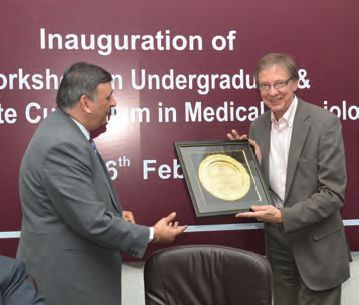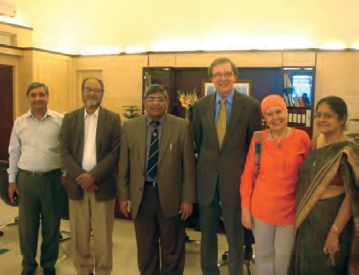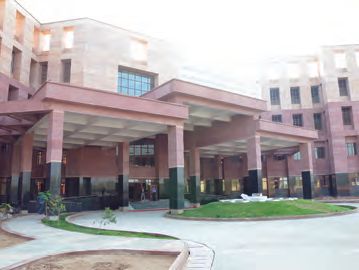
Physiology News Magazine
Meeting Notes: Talking Physiology in India
Events
Meeting Notes: Talking Physiology in India
Events
Richard Vaughan-Jones
University of Oxford, UK
Deputy President, The Physiological Society
https://doi.org/10.36866/pn.93.18
The Physiological Society International Prize, 20 February – 10 March 2013


The invitation by The Physiological Society to deliver its International Prize Lecture in India came as I arrived back from a previous tour of the country. I had visited in late 2011, on a travelling fellowship awarded by Exeter College, Oxford, where I am an Official Fellow. It had been my first trip to India, and I returned with my gastro-intestinal function intact, and with no other ailments. So India was not such an intimidating place after all! I had delivered research lectures in universities and Institutes in Mumbai, New Delhi and Hyderabad. But it had become clear to me that I was barely scratching the surface of scientific activity in India. So I jumped at the opportunity of returning, this time on behalf of The Physiological Society.
The International Prize Lecture is peripatetic within a given country, delivered in several scientific venues, in order to strengthen links with The Physiological Society. Jonathan Ashmore, Society President, had just attended the 100th Indian Science Congress in Kolkata, at the invitation of the local Physiological Society. So I travelled instead to the desert city of Jodhpur (west of Delhi, to a newly opened All India Institute of Medical Sciences: AIIMS) where there was a meeting of national medical school directors, engaged in the design of a new teaching curriculum. After that, it was south to the tropical warmth of Trivandrum in Kerala State (Rajiv Ghandi Centre for Biotechnology). Then back north to the crowded roads of New Delhi (to the country’s first AIIMS), north again to the cooler climes of Panjab University in Chandigarh (a city developed by the architect, Le Corbusier) and, finally, east to historic Lucknow (King George’s Medical University), academic home of the great Indian neurophysiologist, Paintal, and where I delivered a lecture at the brand new and impressive premises of the Central Drug Research Institute.
When combined with my previous visit, that made ten talks in seven cities, in two years. So I have had a snapshot of the health of Indian life-sciences, and of physiology in particular. Unfortunately, one city that beckoned, but with no time to visit, was Bangalore, which houses important national neuroscience research. That must await another trip, should the opportunity ever arise.
The roving lecture, “Ca2+/H+ exchange in the heart: a key element in health and disease”, was a summary of recent cardiac research from my group and co-workers in Oxford, including Pawel Swietach, and my long-standing collaborator, Kenneth Spitzer, in Salt Lake City, USA*. The lecture was a full-on integrative cellular physiology talk, focusing on signalling, intracellular H+ and Ca2+ ion homeostasis, membrane ion transporters, and sub-cellular ionic trafficking. It was informative, therefore, for me to gauge the audience response. I was happy (and not a little relieved) that reaction was positive, appreciative and enthusiastic. A not infrequent cry in the Institutes, however, was that India does not “do physiology”. Integrative cellular work, even when it addresses clinical issues, is being superseded by molecular and genetic approaches, combined with the ever present search for clinical markers of disease. Not unique to India, you might think, but a more rational balance between clinical and basic science has certainly been struck in the UK, which still permits serious physiological approaches to important medical questions. This has been complemented in general by the rise of systems biology, which is quantitative physiology by any other name. India may now need some of this, to bridge between its notable molecular and genetic research and its delivery of efficient and modern clinical care. The problem of invisible physiology, however, is not always as acute as may initially seem. Although India apparently does not “do physiology” as much as it might, it certainly does neuroscience and biophysics. It is just that these subjects do not always assume their rightful position under the umbrella of physiology. Like systems biology, they are physiology by another name. This issue is recognised by the two main Physiological Societies in India (Physiological Society of Kolkata, and the Association of Physiologists & Pharmacologists of India [APPI]). But it would benefit from being promulgated more roundly.
Curiously, physiology as a named discipline is not necessarily in decline in India. Funding of science is currently a priority there, and resources are increasingly being committed. Most impressive is a building programme of six new AIIMS centres, to complement the original in New Delhi. Each centre comprises a new medical school, a dedicated hospital of up to 1,500 beds, and an allied research institute. The new AIIMS buildings, their full clinical and research staff, and their attendant medical students are deliberately sited in the more deprived regions of the country, such as Bhubaneswar, Raipur and Patna, where local medical care has not, until now, been self-sufficient. The six new AIIMS represent a truly massive infrastructure investment by the government, which is to be applauded. When I was visiting the new AIIMS, Jodhpur, I was impressed that the recently appointed medical directors were inclining towards a traditional departmental model of medical teaching within their centres. This includes teaching (and research) based around Departments of Physiology, Anatomy, Pathology & Pharmacology. A remarkable endorsement of a structure that is rapidly disappearing from university medical schools in the West. But for new physiology to flourish as research in the new AIIMS, it must embrace not only molecular and genetic disciplines, but also cutting-edge physiological applications of optical and magnetic resonance imaging, and modern biophysical, electrophysiological and computational techniques, applied at cellular and sub-cellular, as well as organ-system and whole-body level. And this requires investment. Then physiology will provide the much needed bridge between molecular and clinical science.
An enlightened approach to the combination of teaching and research does not always prevail in India. The real money sits in the Research Institutes, which are rising like new Maharajah Palaces on the outskirts of cities, stocked with up-to-date equipment, and manned by highly qualified and dedicated research personnel. If infrastructure funds are maintained (a crucial point), these will match anything in China, Japan or the West. In contrast, investment in medical research is notably at a lower level in many of the universities, where the culture is to emphasise teaching. Once again this dichotomy is not unique, but the contrast in India can sometimes be stark. It can be argued persuasively that excellence in teaching stems from excellence in research discovery. Divorcing one from the other is not always beneficial. For example, elite universities in the UK, like Oxford, Cambridge and London, can only survive as coherent establishments if the link between teaching and research is maintained in an interactive manner. Separation of the scientific palaces in India from higher education in the universities runs the very real risk of a less inspirational educational delivery.
Overall, my Indian experience was immensely positive. I am extremely grateful to my hosts throughout the country, in particular S Sircar & S Mishra (Jodhpur), CC Kartha (Trivandrum), R Mathur (New Delhi), A Grover & R Tewari (Chandigarh), and O Tripathi (Lucknow). Above all, a huge thank-you is owed to Subrata Tripathi (TIFR Mumbai, & Bhubaneswar; Subrata is a longstanding member of the UK Physiological Society) who helped me plan and execute both trips to India. Reflections after the tour are that the flagship Institutes for life sciences are progressive beacons and the main engines of discovery in India. But universities must also have the means to thrive. The Vice Chancellors whom I met in Chandigarh and Lucknow, for example, are actively developing both research and teaching activity in tandem in their universities. This must surely be allowed to redress some of the balance with the stand-alone Institutes. Lastly, the new AIIMS are truly outstanding ventures. I hope that the embrace of physiology as a continuing key subject in medicine is backed by investment in its power for research. This time, my return journey to the UK was not greeted with another ticket to India. But I trust it is not too long before I have the pleasure of greeting friends there again.


*Swietach P, Youm JB, Saegusa N, Leem CH, Spitzer KW, Vaughan-Jones RD (2013) Coupled Ca2+/H+ transport by cytoplasmic buffers regulates local Ca2+ and H+ ion signaling. Proc Natl Acad Sci U S A. May
28;110(22):E2064-73.
